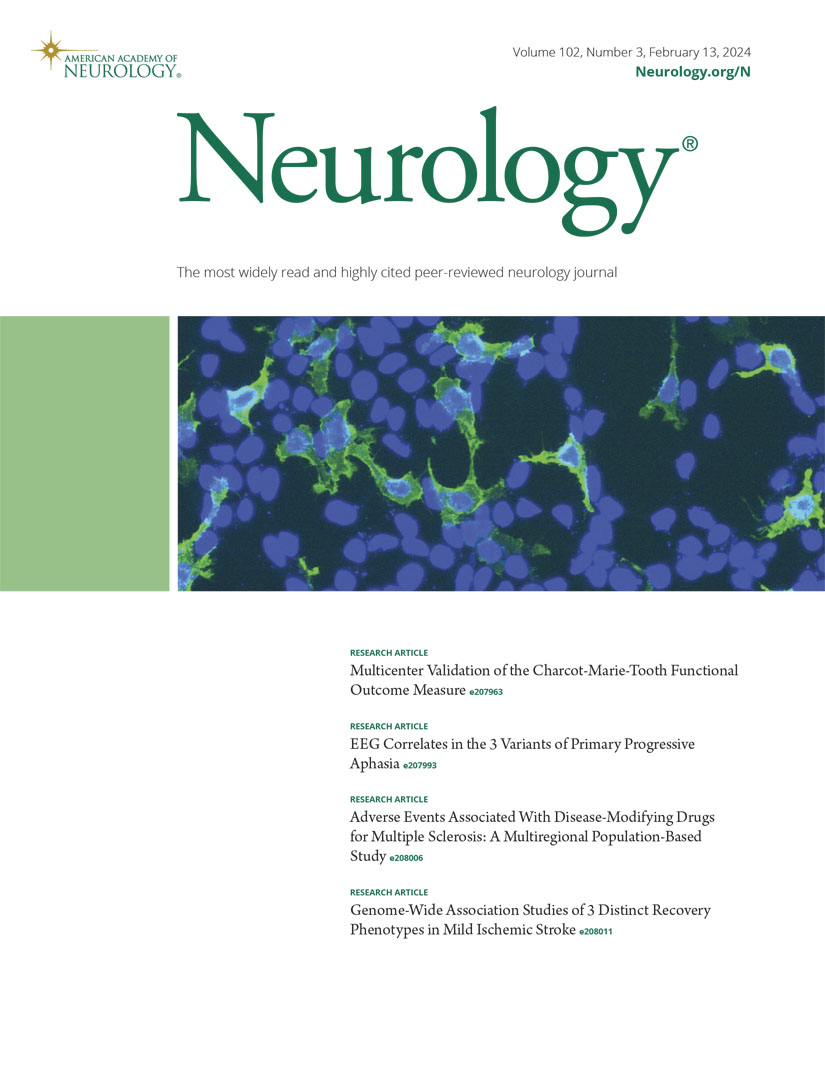Effect of Thrombolytics on Delayed Reperfusion After Incomplete Thrombectomy: Target Trial Emulation.
IF 7.7
1区 医学
Q1 CLINICAL NEUROLOGY
引用次数: 0
Abstract
BACKGROUND AND OBJECTIVES More than half of the endovascularly treated ischemic stroke patients with incomplete reperfusion (expanded Thrombolysis in Cerebral Infarction [eTICI] <3) show delayed reperfusion (DR) on 24-hour perfusion imaging, which is associated with favorable clinical outcome. The effect of intravenous thrombolysis (IVT) on the rates of DR remains unclear. This study aimed to assess the treatment effect of IVT on the occurrence of DR. METHODS Pooled data from 3 randomized controlled trials (EXTEND-IA and EXTEND-IA TNK parts 1 and 2) and 2 comprehensive stroke centers (University Hospitals Graz and Bern) were analyzed. Only patients with a final reperfusion score of eTICI 2a-2c and available perfusion imaging at follow-up of 24 ± 12 hours were included. The primary outcome was the presence of DR on 24-hour follow-up CT/MRI perfusion imaging, defined as the absence of any focal perfusion deficit on perfusion imaging, despite incomplete reperfusion on the final angiography series during thrombectomy. For the secondary analysis, we explored the association between the primary outcome (DR) and the time elapsed between start of IVT and the end of an intervention. To address confounding in observational data, we performed a target trial emulation. RESULTS Of 832 included patients with eTICI 2a-2c (median age 74 years, 49% female), 511 (61%) had DR. There was an independent treatment effect of IVT on DR (standardized risk ratio [sRR] 1.1, 95% CI 1.0-1.3; standardized risk difference [sRD] 8.2%, 95% CI 0.2%-16.1%), after adjusting for age, sex, atrial fibrillation, number of device passes, collateral score, and eTICI. Among those patients who have received IVT (n = 524/832, 63%), when adjusting for the aforementioned covariates, there was a causal effect of shorter time between administration of thrombolytics and end of the intervention on DR (sRR 0.93%, 95% CI 0.87-0.98; sRD -5.2%; 95% CI -9.1% to -1.3%, per hour increase). DISCUSSION Exposure to thrombolytics showed independent treatment effect on the occurrence of DR among patients with incomplete reperfusion after thrombectomy who undergo perfusion imaging at the 24-hour follow-up. The effect of thrombolytics on DR was observed if there was a high chance of therapeutic concentrations of thrombolytics at the time point when the proximal vessel was recanalized, but distal occlusions persisted and/or occurred. CLASSIFICATION OF EVIDENCE This study is rated Class III because it is a nonrandomized study and there are substantial differences in baseline characteristics of the treatment groups.溶栓剂对不完全取栓后延迟再灌注的影响:目标试验模拟。
背景与目的血管内治疗的缺血性脑卒中不完全再灌注(脑梗死扩张性溶栓[eTICI] <3)患者中,超过一半的患者在24小时灌注成像上表现为延迟再灌注(DR),这与良好的临床预后相关。静脉溶栓(IVT)对DR发生率的影响尚不清楚。方法对3项随机对照试验(EXTEND-IA和EXTEND-IA TNK第1部分和第2部分)和2个脑卒中综合中心(格拉茨大学医院和伯尔尼大学医院)的数据进行分析。仅纳入eTICI最终再灌注评分为2a-2c且随访24±12小时可获得灌注成像的患者。主要结果为24小时随访CT/MRI灌注成像有无DR,定义为灌注成像没有任何局灶性灌注缺陷,尽管在取栓期间的最后血管造影系列显示不完全再灌注。对于次要分析,我们探讨了主要结果(DR)与IVT开始和干预结束之间的时间之间的关系。为了解决观测数据中的混淆问题,我们进行了目标试验模拟。结果纳入的832例eTICI 2a-2c患者(中位年龄74岁,女性49%)中,511例(61%)发生DR。IVT对DR有独立治疗效果(标准化风险比[sRR] 1.1, 95% CI 1.0-1.3;标准化风险差异[sRD] 8.2%, 95% CI 0.2%-16.1%),在调整了年龄、性别、房颤、器械通过次数、侧支评分和eTICI后。在接受IVT治疗的患者中(n = 524/832, 63%),在调整上述协变量后,溶栓药物治疗与干预结束之间的时间缩短对DR有因果影响(sRR 0.93%, 95% CI 0.87-0.98;阶跃恢复二极管-5.2%;95% CI -9.1%至-1.3%,每小时增加)。溶栓剂暴露对取栓后不完全再灌注患者24小时随访进行灌注显像后DR的发生具有独立的治疗作用。如果在近端血管再通的时间点溶栓治疗浓度高,但远端血管闭塞持续和/或发生,则观察溶栓对DR的影响。证据分类:该研究被评为III类,因为它是一项非随机研究,治疗组的基线特征存在实质性差异。
本文章由计算机程序翻译,如有差异,请以英文原文为准。
求助全文
约1分钟内获得全文
求助全文
来源期刊

Neurology
医学-临床神经学
CiteScore
12.20
自引率
4.00%
发文量
1973
审稿时长
2-3 weeks
期刊介绍:
Neurology, the official journal of the American Academy of Neurology, aspires to be the premier peer-reviewed journal for clinical neurology research. Its mission is to publish exceptional peer-reviewed original research articles, editorials, and reviews to improve patient care, education, clinical research, and professionalism in neurology.
As the leading clinical neurology journal worldwide, Neurology targets physicians specializing in nervous system diseases and conditions. It aims to advance the field by presenting new basic and clinical research that influences neurological practice. The journal is a leading source of cutting-edge, peer-reviewed information for the neurology community worldwide. Editorial content includes Research, Clinical/Scientific Notes, Views, Historical Neurology, NeuroImages, Humanities, Letters, and position papers from the American Academy of Neurology. The online version is considered the definitive version, encompassing all available content.
Neurology is indexed in prestigious databases such as MEDLINE/PubMed, Embase, Scopus, Biological Abstracts®, PsycINFO®, Current Contents®, Web of Science®, CrossRef, and Google Scholar.
 求助内容:
求助内容: 应助结果提醒方式:
应助结果提醒方式:


